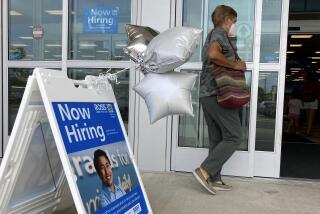U.S. Slashes Its Economic Forecast; Wall St. Blamed : ’88 Growth Prediction Cut to 2.4%
- Share via
WASHINGTON — The White House, acknowledging the “negative impact” of the October collapse on Wall Street, today slashed by nearly one-third its estimate of U.S. economic growth in 1988.
The Administration said it now expects an inflation-adjusted growth rate of 2.4% next year, down from the 3.5% rate it had predicted in August, before the Oct. 19 market plunge.
The stock market collapse will “slow the spending rate by consumers,” Beryl W. Sprinkel, chairman of the President’s Council of Economic Advisers, said at a news briefing.
“Whether it’s already happening, I really don’t know,” he said, responding to a question on whether the stock market decline is affecting Christmas sales.
With another shopping day to go until Christmas, “it’s an open question,” Sprinkel said.
Sees Rebound in 1989
The Administration predicted that economic growth, as measured by the change in the gross national product from the fourth quarter of one year to the fourth quarter of the next, will rebound to 3.5% in 1989 and stay between that level and 3.2% through 1993.
In other forecasts, the Administration said unemployment will remain at its November level of 5.9% through 1988, drop to 5.7% in 1989 and then ease gradually to 5.3% by 1993.
Inflation will drop to 4.3% in 1988 from its 1987 level of 4.7%, then decline to 3.9% in 1989 and to 2% in 1992, the Administration predicted.
On interest rates, the Administration projected that long-term rates, based on 10-year Treasury bonds, would ease to 8% in 1988 and to 7.4% in 1989--down from 8.4% currently.
For short-term rates, the Administration said three-month Treasury bills--now at 5.8%--would ease to 5.3% in 1988 and to 5.2% in 1989.
3.7% in 1st 9 Months of ’87
The Administration issues its economic forecasts twice a year. The new projection will be used in the preparation of President Reagan’s fiscal 1989 budget, expected to be submitted to Congress on Feb. 16.
For the first nine months of 1987, economic growth has been increasing at a rate of 3.7%, according to the Commerce Department. That compares with 1986 growth of 2.2%.
Blue Chip Economic Indicators, a financial newsletter that surveys 51 top economists each month for their forecasts, says the consensus estimate is that the economy will expand at a 2% annual rate in 1988, with inflation rising 4.3%.
Lawrence Chimerine, chairman of a private forecasting service in Philadelphia, said the Administration forecast “is a little on the high side but it is certainly within the range of reasonableness.”
“I wouldn’t quibble with basing their budget projections on numbers like that. I think it makes a lot of sense,” Chimerine said.
Becoming the Norm
Chimerine noted that growth rates between 2% and 3%--while once considered anemic--are becoming more and more the norm. “It’s not possible to keep growing at the rates we did back in the 1950s and 1960s,” he said.
Sprinkel declared that the overall U.S. economy remains sound, despite the current turmoil in financial markets. And he noted that the current growth rate of 3.7% is even exceeding the Administration’s own earlier projection of 3.2% growth in 1987.
“Continued strong growth of U.S. exports is expected to contribute significantly to economic expansion in 1988, as it has for the past year,” he said.
Asked about a recession, Sprinkel said: “We have no recession projected out to 1993.” But he added that doesn’t mean there won’t be another recession between now and then. “If inappropriate policies are pursued, we might get it,” he said.
More to Read
Get the L.A. Times Politics newsletter
Deeply reported insights into legislation, politics and policy from Sacramento, Washington and beyond. In your inbox three times per week.
You may occasionally receive promotional content from the Los Angeles Times.










